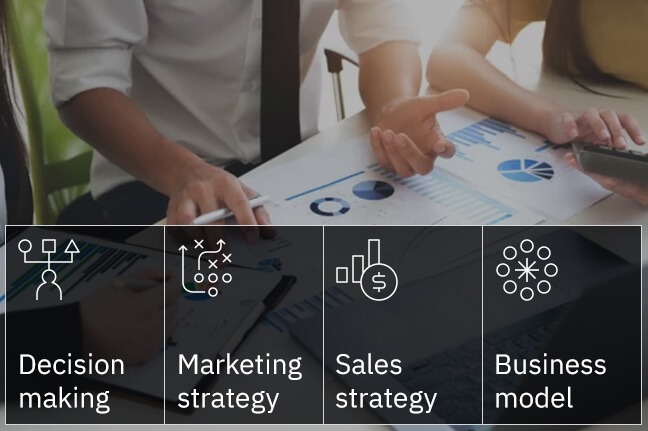Introduction
Trying to navigate the market in 2021 without market intelligence is like fumbling with a bunch of keys in the dark; you try one key after another in the hope that one of them might open the lock. The same goes for your business. Trying different business strategies one after another without any actionable information to back them will only increase frustration, while your competitors power ahead of you. Market intelligence empowers you with information on your market, consumers, and competitors, unlocking opportunities that will result in success and growth for your organization. But to use market intelligence effectively, you need to understand its need and its process. In this article, let us discuss the 6 steps to follow in your market intelligence process that guarantee absolute results.
The need for a market intelligence process

A market intelligence process is vital for an organization as it provides a foundation of information, on which business strategies are built. Effectively executing business strategies is what keeps an organization successful. The key-word here is ‘process’, as without a proper process, your market intelligence efforts may get mired in complexities, and not reach the respective stakeholders. In fact, Forbes defines market intelligence as “the data - and the process - of using it to guide marketing decisions.” It is due to the lack of a proper process that a number of companies give up on market intelligence and fail to realize its true value. The following points will further detail the need for a market intelligence process.
1. Understanding your position in the market
A well-built market intelligence process will give you insights that will not only help you understand the market in-depth, but also your position in that market. You’ll aggregate information on what the market demand is, who your competitors are and what they are doing to meet the market demand, who your target audience is, and what they need, to name a few things. As you analyze this information using various reports, metrics and tools, you’ll be able to evaluate your position in the market and make strategies accordingly to improve it.
2. Evaluating your product or service
A market intelligence process is also important as it familiarizes you with the products already in the market (offered by your competitors), the product trends as well as the features and specifications currently in demand. This will help you evaluate your product/service, and make strategies to modify it for better sales.
3. Targeting the right audience
A market intelligence process will allow you to determine the gender, age, race, location, or attitudes, and interests of your ideal consumer, and thus, focus better on their needs. There are a number of market intelligence techniques you can use to do so, depending on your organization’s position in the market, its nature, and its maturity. Determining the right target audience will aid in making better marketing strategies, and save the effort spent in chasing customers that don’t fit into your customer personas.
4. Conducting competitor analysis
Competitor analysis is such a significant part of the market intelligence process these days that it is often considered a different field of intelligence in itself. However, market intelligence does provide you with the information you need to conduct a competitor analysis, and understand your competitors strengths and weaknesses. This in turn will allow you to understand their failures and successes, learn from them, and then devise strategies to outperform them.
Download Competitive Analysis Template
A market intelligence process, thus, is needed as it helps an organization collect real-time relevant data to:
- Understand the market demands and consumer opinions
- Become customer-centric
- Boost their upselling opportunities
- Reduce risks
- Capture higher market shares
- Give them a competitive advantage
Market intelligence input to the strategy and planning process

Strategy and planning is the domain of the executive or leadership team in an organization, which usually includes the C-suite and the board of directors. Market intelligence can be of immense help to the leadership, as it provides them actionable insights on their major concerns such as:
- The competitive landscape
- The key trends and driving forces in the market
- Customer and potential customer profiles
- Competitive success factors
- Industry tiers and market share
- The market (and competitive) intelligence capabilities of their competitors
The leadership will then use these insights to inform and support their strategies, plans, and decisions on things such as:
- Market and investment opportunities,
- Market penetration, diversification, and/or expansion strategies,
- The 4Ps, i.e. product, price, place and promotion,
- Market development metrics.
Other strategic areas in which market intelligence plays a significant role include:
1. Decision-making
Insights from market intelligence add value to your business, especially when it comes to decision-making. When appropriately configured into a market intelligence process, market intelligence in the form of real-time daily or weekly market reports give the leadership instant access to actionable information, which means more efficient decisions.
2. Marketing strategy
The modern marketing ecosystem is largely based on digital, mobile, social media platforms and online campaigns. However, calculating the ROI of all these marketing activities, determining whether they will work or not, and deciding whether to allocate budgets on them can be difficult, particularly when you have no data to compare to. Market intelligence can provide market insights, as well as information on competitors and other organizations who used similar marketing strategies, which can help you decide which marketing strategy would likely work best for you.
3. Sales strategy
Market intelligence can help make your sales strategy more effective by providing you with your competitor’s turnover, budget plans, future expansion plans, sales numbers, competitors, and much more. It will also provide you market research on sales techniques and trends prevalent in the market, which will further reinforce your sales strategy.
4. Business model
When you have a regular stream of actionable market insights, stats of customer buying habits, and competitors’ market strategy, it is obvious that you’ll be able to make your organization’s business model more stable & result-oriented. When built properly, a market intelligence process can assist your organization in positioning its products, studying market trends, investing the right amount in its marketing campaigns, as well as evaluating its efforts, which will offer you an advantage in the market.
How to create a marketing intelligence process in 6 steps

A marketing intelligence process is like the third-eye which allows you to see all that is happening in the market. It’ll allow you to reach your target audience, learn new business tactics, understand why market leaders succeed and what they do that makes them successful, in addition to identifying trends, even the ones which aren’t so obvious. Here’s how you build a market intelligence process in 6 steps.
1. Identify your competitors
This seems like a simple enough step, but all is not as it seems. You likely have a good grasp on who your direct competitors are, but do you know who your indirect competitors are? Your direct competitors sell or market the same products as your business, and while indirect competitors might not do that, they still compete with your business. For example, let’s say your product is an energy drink, then your direct competitors are other organizations that sell energy drinks. However, your customer might just as easily choose a carbonated beverage instead of an energy drink, which makes the organization producing that beverage your indirect competitor. You can identify direct and indirect competitors through some market research, customer feedback, and monitoring online portals. And, of course, you can (and should) use market intelligence to do that. Once you’ve identified both your direct and indirect competitors, you can move on to deciding the metrics you wish to measure.
2. Choose the metrics you wish to measure
The metrics an organization chooses to measure depend on their goals, and the strategies they deploy to achieve that goal. Organizations generally fall in two categories - ones that are brand-focused, and others that are performance-focused. Brand-focused organizations give more weightage to the aspects of their brand, their category, and their competitors. Performance-focused organizations, on the other hand, give more weightage to demand generation, and their sales efforts. Naturally, it is these respective metrics that they should focus on to gain a competitive advantage.
Brand-focused organizations should measure and pay attention to metrics such as brand advocacy, affinity, appeal, association, awareness, loyalty, perception, personality, reputation, recall, preference, strength, sentiment, salience, trust, usage and of course, competitors’ performance & tactics. Pay special attention to the kind of content your audience likes. They should use market intelligence to continuously collect information pertaining to these metrics, and deliver them to their marketing teams in the form of daily alerts and weekly or monthly reports.
Performance-focused organizations should measure and pay attention to critical sales metrics such as their competitors’ annual recurring revenue, sales budget, average revenue per user, win rates, conversion rates, acquisition channels, sales tactics, and the like. A market intelligence process that allows your sales team to constantly be aware of these metrics should be put in place. Integrating your sales enablement tool to your market intelligence system is a great way to streamline things in this case.
3. Understand how to use market intelligence effectively
In 2021, almost every business uses market intelligence in some form or another. From a small company that does basic or unstructured research using the internet on their target market and competitors, to huge enterprises that pay millions of dollars for data on their competitors and the markets. Neither of these organizations is using market intelligence effectively. In fact, 50% of organizations don’t know how to use M&CI properly in decision-making. When an organization creates a market intelligence process, there are 3 things they should look out for to ascertain its ROI.
- Data costs
- Labor costs
- Cost of poor decisions
Now, the company that does basic research has no data cost, as surfing the internet costs nothing. Little to no labor costs are incurred, as there’s no team of analysts decoding data that is fetched. However, the cost of poor decisions is probably immense, which is why this company is still a small company even after being in the market for a long time.
On the other hand, the enterprise-sized organization is paying through their noses for data, labor costs to analyze that data are probably high too, as the organization likely has teams of analysts for this specific job. However, their cost of poor decisions is really low, which explains why they are an enterprise-sized business. They do, however, hemorrhage money in labor and data which could be saved with a more effective MI process.
A balanced approach would be to use a market intelligence software, which will incur moderate data costs, incur moderate labor costs as a modest amount of analysis is required, while saving you from the cost of poor decisions entirely.
4. Perform a market and competitive analysis
The next step would be to perform a market and competitive analysis. Using the insights gleaned from your MI process, design a market and competitive analysis that can be shared with your organization’s stakeholders for easy interpretation. Bear these things in mind when doing so:
- Provide a context
Not everyone in your organization may be used to understanding how numbers and visual representations in the analysis work. Next to every statistic in the analysis, provide some context about what these insights mean for the organization, whether good or bad. Adding a benchmark to measure statistics would be a good idea too.
- Provide recommended actions
Statistics in themselves are no good if you or your stakeholders don’t know what to do with them. Every statistic is either an opportunity or a threat that must be taken advantage of or dealt with. Describe a plan of action as to what should be the appropriate response to every statistic you put in your analysis.
- Provide Proof
Although your stakeholders are not going to doubt the information you put in the analysis, it is always better to furnish them with specific resources for better understanding. Also, they might have to explain it to a customer, client, or another stakeholder in the future, so an attached resource to any statistic or a methodology on how you reached a conclusion is a must.
- Keep it short
The stakeholders in your organization, particularly the leadership, are busy people who have a schedule to stick to. Lengthy analyses that take hours to comprehend will waste their valuable time, and more likely not be paid adequate attention to. So skip the granular details, and provide information that can be quickly consumed and understood.
Keeping these things in mind when designing a market and competitive analysis will ensure your organization makes the most of it.
5. Deliver market intelligence throughout the organization
To ensure that market intelligence is utilized effectively throughout the organization, certain things need to be taken into consideration.
- It gets to the right stakeholders
- It gets to them in a timely manner
- It is easy to understand
Doing all of this requires figuring out an appropriate delivery process. Doing this manually is labor-intensive and prone to faults, even if you use a CMS. Markets are highly-dynamic, and the number of insights you get each day, each week and each month can be overwhelming. Then there’s the question of turning them into daily insights as well as weekly, monthly, and/or quarterly reports for the stakeholders to understand the trends better. Finally, you need to send them to the right stakeholders. Not difficult, but laborious.
A better approach is to use a market intelligence platform like Contify that integrates into your CMS, can convert insights into alerts and reports, and can be configured to send personalized insights to different stakeholders.
6. Transforming insights into action
The goal of market intelligence is for a business to be able to make smart and strategic decisions with the information it provides. This generally means more sales, better products or services, a larger market share, more customers, more brand awareness within the target audience, in addition to other business objectives the organization might have. For this to happen, intelligence, strategy and action need to have a direct link, in order to be defined as a process. Organizations need to establish this link on their own, as market intelligence is just one piece of the puzzle. The process should ideally look like this:
- The market intelligence process provides insights
- Those insights are given a context by your market intelligence team, if you have one, or by the stakeholders themselves in case you don’t
- The information is translated into specific business questions, that need to be answered with strategies
- Strategies should be formulated after determining the best course of action in the present and future market landscape
- These strategies should be communicated to everyone involved in their execution
- Actions should be taken based on these strategies
If you follow this process from insight to action accurately, the results will speak for themselves.
Download M&CI Process Template
Conclusion
Today’s world is data-driven, and organizations that use a market intelligence process are able to take full advantage of it. Similarly, an inefficient market intelligence process, or worse no process at all, can quickly become a burden on an organization. The market intelligence process described above will hopefully give you some ideas on how to set up a similar system for your own organization, and enable you to be more competitive. Finally, a market intelligence tool like Contify can help streamline your market intelligence process, so consider discussing with your M&CI team, or a corresponding team that handles your market intelligence activities.










